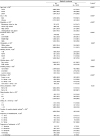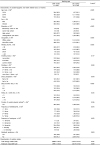Abstract
BACKGROUND/OBJECTIVE
SUBJECTS/METHODS
RESULTS
Figures and Tables
Table 1
General characteristics and Health-related factors of workers according to metabolic syndrome in KNHNES, 2016 (n = 4,666)

All estimates were weighted and calculated taking the complex study design into account.
1)P-value were obtained from a chi-square test for categorical variable.
2)All values are expressed as the number of subjects for each category n (%).
3)The response base differs because there are cases of irrelevant responses or no responses.
4)Practice of aerobic physical activity was assigned “yes” if the subject practiced moderate-intensity physical activity for a wk for more than 2 hrs 30 minutes or practiced high-intensity physical activity for more than 1 hr and 15 minutes or practiced with moderate intensity and high-intensity physical activity (2 minutes moderate intensity for high intensity one minute)
*P < 0.05
Table 2
Anthropometry, biochemical and, nutrition intake characteristics of workers according to metabolic syndrome in KNHNES, 2016 (n = 4,666)

All estimates were weighted and calculated taking the complex study design into account.
1)P-value were obtained from the general linear model (GLM) for continuous variables and from a chi-square test for categorical variable.
2)Values are expressed as mean ± SD or each category n (%).
3)The response base differs because there are cases of irrelevant responses or no responses.
*P < 0.05
Table 3
Odds ratio and 95% confidence interval of metabolic syndrome according to the workers' health-related factors characteristics in KNHNES, 2016

OR, Odds Ratio; CI, Confidence Interval.
1)Model 1: crude.
2)Model 2: adjusted for sex, age and body mass index.
3)Model 3: adjusted for sex, age, body mass index, education, economic level, smoking status, drinking, stress perception, practice of aerobic physical activity, frequency of eating-out, total energy intakes (kcal), protein (g/1,000 kcal), fat (g/1,000 kcal), n-6 fatty acids (g/1,000 kcal) and riboflavin (mg/1,000 kcal).
*P < 0.05 (by multiple logistic regression analysis).
Table 4
General characteristics of workers according to working type in KNHNES, 2016 (n = 3,273)

All estimates were weighted and calculated taking the complex study design into account.
1)P-value were obtained from the general linear model (GLM) for continuous variables and from a chi-square test for categorical variable.
2)All values are expressed as the number of subjects for each category n (%) or mean ± SD.
3)The response base differs because there are cases of irrelevant responses or no responses.
4)Practice of aerobic physical activity was assigned “yes” if the subject practiced moderate-intensity physical activity for a week for more than 2 hrs 30 minutes or practiced high-intensity physical activity for more than 1 hour and 15 minutes or practiced with moderate intensity and high-intensity physical activity (2 minutes moderate intensity for high intensity one minute)
*P < 0.05




 PDF
PDF ePub
ePub Citation
Citation Print
Print



 XML Download
XML Download